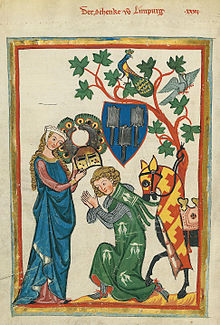Ailettes


The ailettes (in German armpit shields ) are mostly rectangular shoulder plates made of wood and covered with a layer of leather or linen . They were often painted with the coat of arms of their bearer.
history
The ailettes, like many armaments innovations in the Middle Ages , came from France and were worn around 1250–1310. The function of these "armpit shields" as body protection is rather doubtful. They were mainly used to identify knights , as they could no longer be distinguished from enemies due to the chain armor and the full helmet ( pot or bucket helmet ) that were common around 1300 . The term ailettes comes from the French les ailettes, which means 'the wings'.
Function and distribution
In the absence of original pieces, one can only speculate about the actual function of these armor shields, which are known as armpit shields in German-speaking countries. The main point against the function as body protection is the fact that its use is largely limited to the French or French-influenced cultural area. In the German-speaking area there are only representations of such armpit shields on grave slabs or miniatures in the Rhine region, Westphalia and Hesse . The French fashion only appears on the equestrian seal of King John the Blind of Bohemia (killed in 1346 at the Battle of Crécy ) from the Luxembourg dynasty , who was related by marriage to the French royal family.
As body protection, ailettes would only have made sense made of more resistant materials such as metal. A sword cut derived from the pot helmet or bucket helmet could possibly be caught in this way. However, these small shields usually don't seem to have been placed horizontally on the shoulder. Apparently they towered over the shoulder girdle laterally in the manner of small wings ( ailettes , ailerons ), thus clearly showing the coat of arms of the wearer when viewed from the side. Round or oval specimens have been handed down on some contemporary miniatures.
The oldest dated representations (1274) of these shoulder pieces come from a French manuscript of the Grail novel. On a small bronze relief in the Metropolitan Museum in New York you can even see ailette-shaped knee tiles.
The few fully plastic depictions of warriors with armpit shields occasionally show raised coats of arms. It is possible that such reliefs were applied to the shields with models . A corresponding model stone was found in 1926 during the excavations of Montfort Castle (Starkenberg) in what is now Israel . The object shows two stylized barbs (fish) about 11 centimeters long , which are interpreted as the “ talking coat of arms ” of the Counts of Bar .
literature
- Helmut Nickel: About Ailettes and Achselschilde. In: weapons and costume studies. Journal of the history of weapons and clothing. Vol. 44, Issue 2, 2002, ISSN 0042-9945 , pp. 197-212.